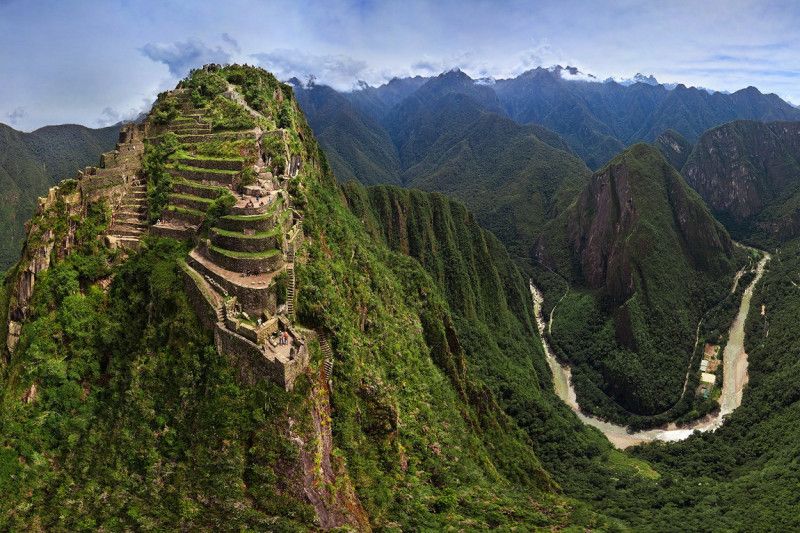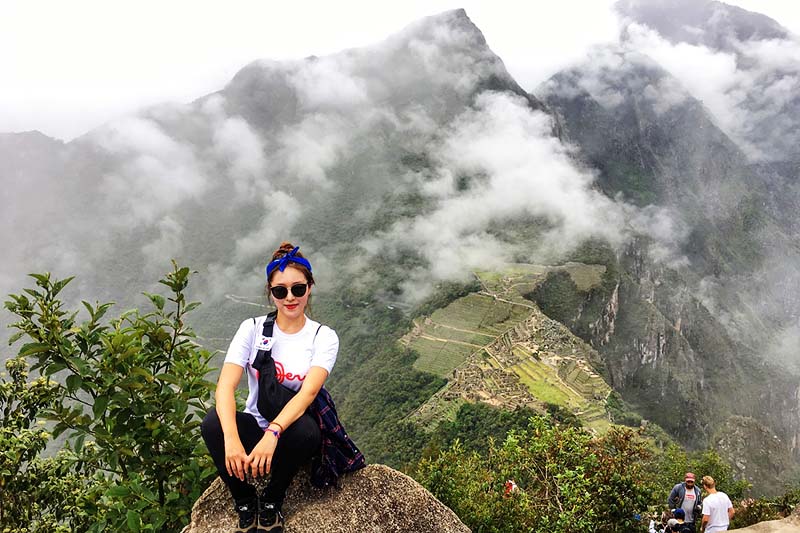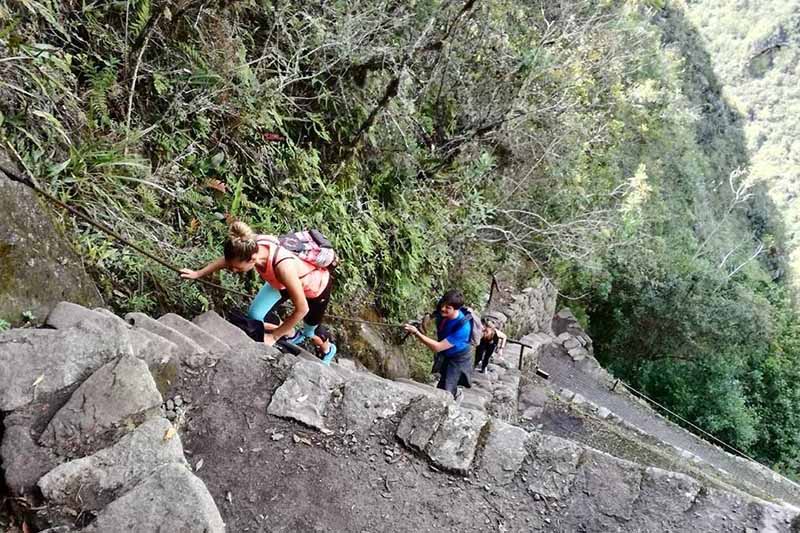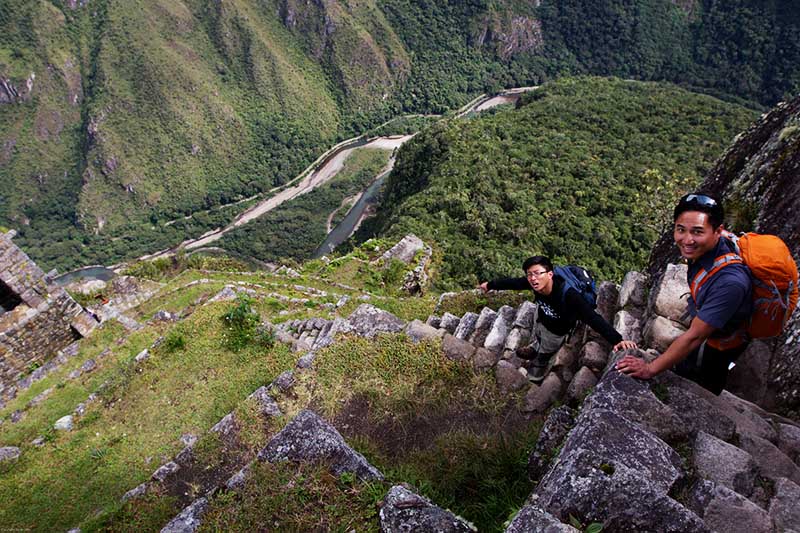Get to the top of Huayna Picchu
When visiting the Inca city of Machu Picchu, you can experience different adventures. Each ticket allows you to explore various areas and discover some of the most enigmatic constructions, such as the Temple of the Sun, the Temple of the Condor, the Temple of the 3 Windows, and more. Additionally, you can also hike to Huayna Picchu. Yes, the great mountain that takes center stage in the classic postcard photo of Machu Picchu. Reaching the summit of this peak is the most popular adventure—find out how to do it and immortalize your visit to this wonder of the world.
- Huayna Picchu Mountain
- Height of Huayna Picchu Mountain
- Is it difficult to reach the top?
- Requirements to access the Huayna Picchu mountain trail
- How to start climbing the mountain?
- What is the hike near the summit like?
- And what is the summit like?
- Keep the following in mind before the hike
- The Huayna Picchu summit in images
- Frequently Asked Questions

Aerial view of the Huayna Picchu summit
The rainy season on Huayna Picchu mountain
From November to March, the rainy season occurs, during which there is a higher probability of precipitation in the Inca citadel, and therefore on Huayna Picchu mountain. This weather condition can make the ascent to the summit more difficult, making the stone paths slippery. That is why you should take extra precautions if you undertake this adventure during the rainy season; carrying waterproof clothing and hiking shoes is essential. Despite this, experiencing this adventure in the rain, with mountain landscapes shrouded in clouds, will be one of the most unforgettable experiences you can have in the world.
Huayna Picchu Mountain
- It is the most important mountain of the Machu Picchu archaeological sanctuary, which stands out in the background of the classic photos.
- To reach the summit, the Incas built hundreds of stone steps; along the entire path, as well as at the end of the trek, you can enjoy impressive panoramic views.
- Along the paths of this mountain, the Incas also built famous temples such as the Temple of the Moon, a mysterious site isolated from the other Inca constructions.
- The greatest challenge and attraction of the route is overcoming the steep steps near cliffs. It is considered one of the best short hikes in the world.
- Along the way, you can also observe the diverse flora surrounding the Inca citadel, adding even more value to the route.
| FEATURES OF HUAYNA PICCHU MOUNTAIN | |
|---|---|
| Aspect | Description |
| Name | Huayna Picchu (from Quechua “young mountain”) |
| Location | Within the Machu Picchu Historical Sanctuary, Cusco region, Peru |
| Altitude | Approximately 2,693 meters above sea level |
| Entrance | Huayna Picchu Mountain Trail (3A) |
| Entry groups | 1st group: 07:00 / 2nd group: 09:00 |
| Daily entries | 400 spots per day: 350 online and 50 in-person |
| Restrictions | Only for visitors over 12 years old. Available all year round |
| Ascent time | One and a half hours (and 45 minutes to descend), depending on pace and physical condition |
| Difficulty level | Moderate to high. Steep stairs and narrow stone-carved paths |
| Recommended time to visit | From April to October (dry season, with lower probability of rain) |
Height of Huayna Picchu Mountain
- The summit of Huayna Picchu is located at 2,720 meters above sea level (m.a.s.l.), which is equivalent to 8,923 ft. Therefore, it is normal for visitors to experience shortness of breath, agitation, dizziness, and other symptoms of so-called “altitude sickness.”
- To avoid these symptoms and prepare better, we recommend spending at least two days in the city of Cusco or the Sacred Valley doing light activities.
- Compared to the Inca citadel (2,430 meters above sea level), the summit of Huayna Picchu rises approximately 300 meters higher.
Is it difficult to reach the top?
- The hike to the summit is considered medium to high difficulty due to the number of steep steps.
- The difficulty will mainly depend on the visitor’s physical condition; no one will rush you, so take the hike at your own pace.
- At a certain point during the ascent, you will encounter the popular “Stairs of Death,” the most challenging section, but the rest can be completed with moderate effort.
- The return is easier since it is mostly downhill, and you will have time to rest and regain energy at the summit.
Requirements to access the Huayna Picchu mountain trail
- The most important requirement to access this trail is to purchase the entry ticket “Huayna Picchu Mountain Trail (3A),” available year-round.
- As the most visited attraction in Machu Picchu, the ticket must be purchased 2 months in advance at any time of the year.
- For safety reasons, the climb is only allowed for people over 12 years old. The trail is also not suitable for those with a fear of heights. Additionally, if you have any medical condition that prevents you from making strenuous physical effort, it is best to avoid the hike.
- The ticket includes the route through Circuit 3 of the Inca citadel (Royal Route). After that, you must head to the mountain entrance, located in the Sacred Rock area (follow the signs). Remember to arrive at the time indicated on your ticket.
How to start climbing the mountain?
- The first thing you must do is register your entry at the control booth, which is at the start of the trail. You must do the same upon exiting.
- The beginning of the path will not present much difficulty. However, as you ascend, the difficulty increases. Effort may be affected by physical condition, age, and weather. If the day is very hot, the effort will be greater.
- It is estimated that there are approximately 2,000 steps to climb (1.5 kilometers of paths to the summit). One of the most difficult sections is the so-called ‘Stairs of Death,’ a set of steep steps with little space between each step. You need to use your hands to pass this section!
- Remember that the best way to climb the mountain is at your own pace, whether slow or fast. Reaching the summit is not a race.
What is the hike near the summit like?
- After ascending the ‘Stairs of Death,’ visitors will be very close to the summit. To complete the route, they must pass through a small Inca enclosure and climb a final set of stairs to reach the top.
- In this last section, visitors can observe terraces, enclosures, agricultural terraces, and other structures that may have served as lookout points. From here, it is already possible to see the Inca citadel of Machu Picchu from a unique angle.
What is the summit like?
- From the summit of Huayna Picchu, you have a spectacular and breathtaking view of Machu Picchu and its entire geographic surroundings.
- However, during the rainy season, clouds may cover the mountainous landscape, though you can still glimpse a mystical and unique panorama.
- At the summit, you will find cozy areas to rest and take in the entire surrounding scenery.
- The summit is rocky, so care must be taken not to trip when taking photographs. Security personnel are present to assist if needed.
- For safety reasons, taking photos that endanger the visitor is not allowed. For example, standing too close to cliffs is prohibited.
Keep the following in mind before the hike
- Entry to Huayna Picchu includes the route through Circuit 3, which covers the lower part of the Inca citadel along with some of the most important structures and temples.
- You can spend up to 6 hours in total within Machu Picchu (mountain route plus Circuit 3 tour).
- Entry tickets have fixed schedules: the first group enters from 7:00 to 8:00 a.m., and the second group from 9:00 to 10:00 a.m. Therefore, make sure to be at the entrance at the time indicated on your ticket.
- Carry a backpack that leaves your hands free and can hold essential items for the hike: water, snacks, rain poncho, extra clothing, camera, identification, etc.
- During the rainy months (November to March), it is essential to carry a poncho or waterproof clothing to ensure that possible rain does not ruin the adventure.
- Book your entry to Huayna Picchu, the most popular mountain in Machu Picchu, 2 months in advance, regardless of the season of your visit.
- Remember to acclimatize beforehand in the city of Cusco or the Sacred Valley to complete the Huayna Picchu route comfortably.
- During the hike, keep the narrow sections clear. Especially for visitors descending from the summit.
- Follow the signage along the mountain. Do not risk your safety by taking photos near cliffs or in highly dangerous areas.
- If you cannot find availability for Huayna Picchu, try choosing another date for your visit. Another good option is to climb Machu Picchu Mountain, a similar hiking route.
The summit of Huayna Picchu in images
Frequently Asked Questions
1) What is the Huayna Picchu mountain like?
Huayna Picchu is the mountain that rises right behind the Inca citadel of Machu Picchu, visible in the classic postcard view of the archaeological site. It is a historic peak known for its steep trails and for offering one of the most breathtaking views of the entire historic sanctuary.
2) How high is Huayna Picchu?
The summit of Huayna Picchu is at 2,720 meters above sea level, about 300 meters higher than Machu Picchu. From there, you get a spectacular panoramic view of the surrounding geography.
3) Is the hike to Huayna Picchu very difficult?
The difficulty is moderate to high, depending on your physical condition. There are steep sections and very narrow staircases, especially the so-called “Stairs of Death,” which require caution. However, you can overcome it by moving at your own pace and calmly.
4) What ticket do I need to enter?
You must purchase the “Huayna Picchu Mountain Route (3A)” ticket, which also includes the tour of the lower part of the Inca citadel. This ticket sells out quickly, so it is recommended to book at least two months in advance.
5) What time can I enter Huayna Picchu?
There are two entry times: the first group enters from 7:00 to 8:00 a.m., and the second from 9:00 to 10:00 a.m. It is important to arrive on time, as access control is strict and entry outside the assigned time is not allowed.
6) How long does it take to reach the summit?
The ascent usually takes about one and a half hours on average, depending on each person’s pace. The descent takes approximately 45 minutes. In total, the full experience lasts around 2.5 hours.
7) What age must I be to climb?
For safety reasons, only people over 12 years old can access the hike. Additionally, it is not recommended for those with vertigo, heart or respiratory problems, or any condition that limits intense physical effort.
8) Do I need to be acclimated for the hike?
Yes, it is recommended to spend at least two days in Cusco or the Sacred Valley before making the ascent. This will help you adapt to the altitude and avoid symptoms of altitude sickness, such as dizziness or fatigue.
9) What will I see during the hike?
Besides the beautiful views of the natural surroundings, along the way you can observe archaeological remains, Inca terraces, and temples such as the enigmatic Temple of the Moon (only available with the Gran Caverna or Temple of the Moon (3A) route ticket), a ceremonial site hidden among the rocks of the mountain.
10) What is the best time of year to hike?
The ideal season is between April and October, during the dry season. During these months, there is less rain, better visibility, and more favorable conditions to enjoy the hike and the views from the summit.
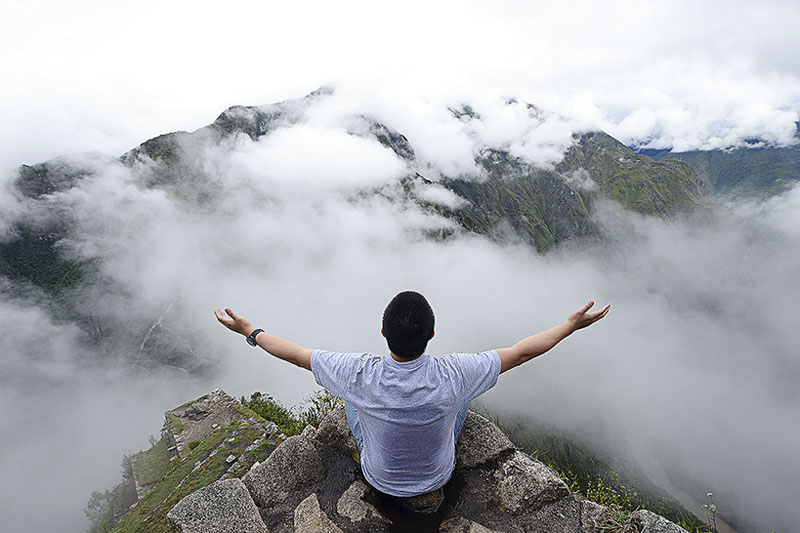
Huayna Picchu summit among the clouds
Advice from people who have been there
 By: Gabriel G.
By: Gabriel G.“Dream Views“
“A physically demanding hike, not suitable for people with vertigo, but every step on the mountain is worth it. The views are incredible, and you feel on top of the world. It is not an impossible climb, but it is challenging; taking it slowly and resting, anyone with an acceptable fitness level can do it.“
By Ticket Machu Picchu – Last updated, October 29, 2025
